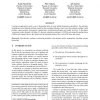Free Online Productivity Tools
i2Speak
i2Symbol
i2OCR
iTex2Img
iWeb2Print
iWeb2Shot
i2Type
iPdf2Split
iPdf2Merge
i2Bopomofo
i2Arabic
i2Style
i2Image
i2PDF
iLatex2Rtf
Sci2ools
WSCG
2003
2003
Comparison of Accelerating Techniques for Discontinuity Meshing
Creating an appropriate mesh is one of demanding tasks of many global illumination algorithms. Discontinuity meshing proved to diminish artifacts caused by other meshing strategies. Since naive discontinuity meshing would produce a great amount of geometric computations, accelerating techniques are usually involved. In this paper, we present results obtained with help of k-discrete orientation polytopes (k-DOPs) and oriented bounding boxes (OBBs) and compare them to previously used accelerating schemes like voxels, BSP-trees and octrees.
Global Illumination Algorithms | K-discrete Orientation Polytopes | Naive Discontinuity | WSCG 2003 |
| Added | 01 Nov 2010 |
| Updated | 01 Nov 2010 |
| Type | Conference |
| Year | 2003 |
| Where | WSCG |
| Authors | Karel Nechvíle, Petr Tobola, Jiri Sochor |
Comments (0)

